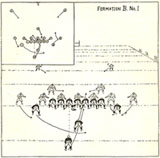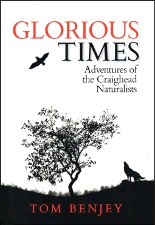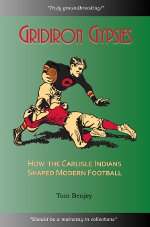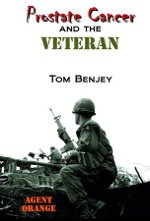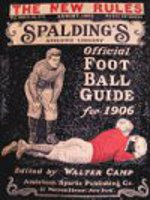Today’s post is something different. It isn’t mine. I rejected offers from others who have offered to supply posts in the past. But this time it was me who did the asking. Sheldon Cohen wrote up a short piece on the 80th anniversary of the 1940 NFL draft that I find very interesting. He is the son of Gus Cohen who, among a number of other things, played football at Albright College under Coach Lone Star Dietz. We met at Dietz’s induction into the Albright College Hall of Fame. Lone Star was important to Gus and his family because he acted like a second father to Gus, who had lost his father to an early death.
Gus graduated from Albright College in 1940 where he was an All-East and 2nd/3rd team All-American lineman, playing for 2 Hall of Fame coaches, Biggie Munn (who recruited Gus from high school and later became famous as the coach and AD at Michigan State) and Lone Star Dietz (Pop Warner’s coaching protege). The draft which concluded today marks 80 years from the time Gus was drafted.
The draft and professional football were both very different. Somehow, Gus had 2 offers from NFL teams–the Philadelphia Eagle offered him a $1,000 bonus and the Brooklyn Dodgers $500. He had friends on both teams, namely his college teammate, Dick Riffle, on the Eagles (Dick was an All-American at Albright and All-Pro for the Eagles) and Leo “Moose” Disend on the Dodgers (Moose later played for the Green Bay Packers).
Gus decided to sign with the Dodgers for less money. His eldest brother, Sam (after whom I’m named), had been murdered in 1939 and Gus was very close to his mother, Sadie (after whom Sandy* is named). Signing with the Dodgers enabled Gus to be with his mother and family in New Jersey after Sam’s untimely passing at the age of 39.
Things are obviously very different with the draft and the NFL today. The one connection the family has with the NFL is cousin Barbara Bashein’s daughter, Dr. Robin West, who is Head Team Physician of the Washington Redskins (the team was named after Lone Star, a Native American, by George Preston Marshall in 1933 when the team was the Boston Braves and Lone Star was the coach).
Times have changed.
*Sandy is Gus’s daughter and Sheldon’s sister.
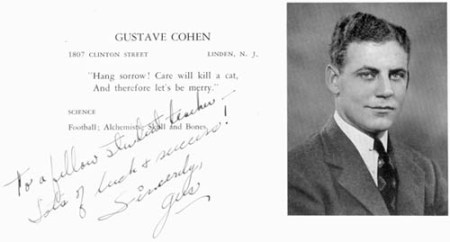
From a classmate’s 1940 Albright College yearbook.

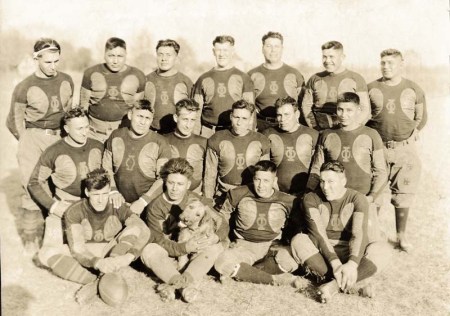 For years I’ve wondered what the Oorang Indians’ uniforms looked like, having only seen black and white photos of them. For those who aren’t familiar with the Oorang Indians, they were an early NFL team formed by Jim Thorpe and Walter Lingo, owner and operator of the Oorang Airedale mail-order kennel. A complete history of the team can be found in Walter Lingo, Jim Thorpe, and the Oorang Indians by Chris Willis. A much shorter version is included in my book Doctors, Lawyers, Indian Chiefs.
For years I’ve wondered what the Oorang Indians’ uniforms looked like, having only seen black and white photos of them. For those who aren’t familiar with the Oorang Indians, they were an early NFL team formed by Jim Thorpe and Walter Lingo, owner and operator of the Oorang Airedale mail-order kennel. A complete history of the team can be found in Walter Lingo, Jim Thorpe, and the Oorang Indians by Chris Willis. A much shorter version is included in my book Doctors, Lawyers, Indian Chiefs.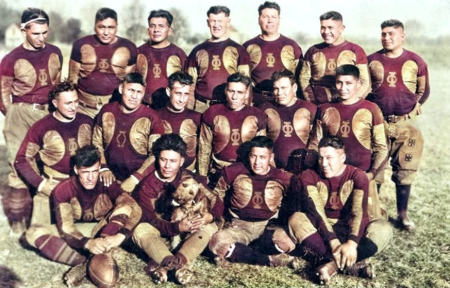
 A black & white closeup of a player sheds a little light on this question. Where the colorized photo has the same color on the sides of the jersey as on the pants but in the black & white photo, it is clear the sides of the jerseys are darker than the pants. My guess would be that the jerseys are a different color than the pants, possibly orange. Although Spalding’s list their PTP style of pants as being brown in color. Photos I’ve seen tend to be tan (a lighter shade of brown) or gold (special orders were accepted). Since the pants in the Oorang photos aren’t shiny, I’d guess they are tan.
A black & white closeup of a player sheds a little light on this question. Where the colorized photo has the same color on the sides of the jersey as on the pants but in the black & white photo, it is clear the sides of the jerseys are darker than the pants. My guess would be that the jerseys are a different color than the pants, possibly orange. Although Spalding’s list their PTP style of pants as being brown in color. Photos I’ve seen tend to be tan (a lighter shade of brown) or gold (special orders were accepted). Since the pants in the Oorang photos aren’t shiny, I’d guess they are tan.